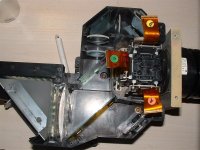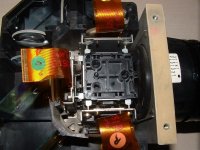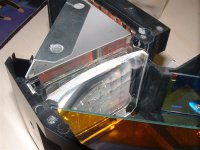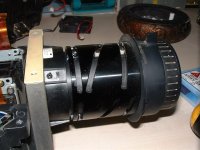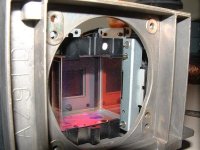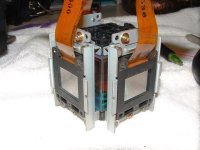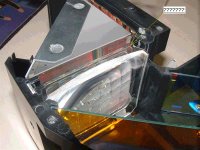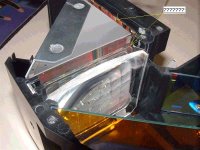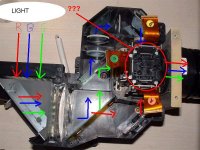thanks for the pics...
imagine these were 15" tft displays and you would convert the size up to this; holy sh*** that would be a HUGE projector... but those were just thoughts 🙂
one more thing would be interesting to me: of what does this prism inside the panel array consist? four prisms alligned to a cube?
imagine these were 15" tft displays and you would convert the size up to this; holy sh*** that would be a HUGE projector... but those were just thoughts 🙂
one more thing would be interesting to me: of what does this prism inside the panel array consist? four prisms alligned to a cube?
shlomid said:yes I think it is used to get even lighting
BTW you can see in the pic there is 2 lens
this 2 lens partition the light and recombine the light ,
turn into the symmetrical light
My guess about lenses in the ????? pics
O.K. Here's my semi-educated guess. I kind of disagree with what others have said about those lenses having been used to even out the light. I think that's sort of what they do, but more accurately I think they are used in that specific way for this very specific and technical reason: Those look like lenticular arrays that, in this case, I think are used to correct for color aberation that is inherant in some types of lambs and reflectors and worsened by the 1st stage prism. (For those that don't know, prisms are used to bend/redirect light, change image orientation, and/or split light into the idividual color spectrums.) If anyone can remember the old overhead projectors, some of them had an adjuster dial that actually controlled an axuator that would slighty bend the fresnel lens to adjust for color aberation that would occur with certain types of lambs and reflectors. Since white light consists of all the colors mixed together, certain lamp and reflector materials can't focus/reflect differing light waves at precisely the same angles and would therefore exhibit prism-like effects. If this occurs in a optical setup, you can get, for example, hypothetically the red and green light spectrums reflected at one angle, but the blue spectrum reflected at a slightly different angle, just enough to where blue light would come out of the white light mix and be visibly distinguishable. So, in the case of the overhead projector, the fresnel can be very slightly bent, resulting in a change of the light path just enough to 'resync' all the spectrums of light together so that any aberant color would be no longer detectable. Furthermore, we see in the pictures that the manufacturer of this projector used a prism to redirect the light path from the lamb by 90 degrees. (That way they could make the light engine more compact, and those acrylic prisms probably cost less that a first surface mirror!) Yet, since no optical system is perfect, perhaps their choice to use a prism introduced such color aberation, undesirably splitting some of the color spectrum, and as stated, they used the lenticular array to refocus the light path. My assumption fits logically because aberation increases as the light expands radially, therefore requiring more and more correction the farther the light radiates outwardly. A lenticular array basically consists of a bunch of individual fresnel lenses arranged in rows and columns and is usually used as a light spreader. So, if color aberation is a problem, it would show up worse along the outer edges of the image stage. So, a lenticular array would be perfectly suited for the task of correcting this aberation since the lens angles of each indivual fresnel making up the array could be ground more and more agressively the farther each one was from the center of the lens array, thus making for a cheap but effective solution. I had considered, like some others who've responded to this post, that they could just be used to even out, or more accurate to my first thoughts, spread the light over the image field more evenly. But, I changed my mind because, if that were the case, I don't understand why you would need two of them. It seems to me that whatever the first one did to the light, the second one would effectively undo. But, in the logic of my assumption, the use of two would make sense, in that in projection systems, the light source and its reflector are positioned at precise focal points so that the light is properly delivered to the condensor lens. Yet if they had went with the approach used in the old overheads, they would have needed a lot more and probably larger components to pull it off, plus the focus of the light would have been effected by the bending of a single, large fresnel, resulting in not as much "effective" light being passed through the condensor lens and onto the image stage. So, it seems by using two lenticular arrays, they were able to preemptively correct the color aberation introduced by the prism with the first array, and then correct for the loss of light focus with the second array. In other words, by using two arrays, they've undone the color aberation introduced by the prism and canceled out the focal distortion introduced by the arrays themselves. This seems to me the most reasonable and logical answer to the question of what they're used for. Then again, it is 4:30 in the morning as I type this, and I'm tired, sleepy, got a slight headache, and in a little bit of a 'mightier than thou' mood. So, it could be that I'm just really in an incoherant stooper and blabbing on mindlessly without really knowing what the heck I'm talking about! You be the judge.
DIYinTN
P.S. If the latter is the case, I'm new here, so please don't beat me up too badly.
O.K. Here's my semi-educated guess. I kind of disagree with what others have said about those lenses having been used to even out the light. I think that's sort of what they do, but more accurately I think they are used in that specific way for this very specific and technical reason: Those look like lenticular arrays that, in this case, I think are used to correct for color aberation that is inherant in some types of lambs and reflectors and worsened by the 1st stage prism. (For those that don't know, prisms are used to bend/redirect light, change image orientation, and/or split light into the idividual color spectrums.) If anyone can remember the old overhead projectors, some of them had an adjuster dial that actually controlled an axuator that would slighty bend the fresnel lens to adjust for color aberation that would occur with certain types of lambs and reflectors. Since white light consists of all the colors mixed together, certain lamp and reflector materials can't focus/reflect differing light waves at precisely the same angles and would therefore exhibit prism-like effects. If this occurs in a optical setup, you can get, for example, hypothetically the red and green light spectrums reflected at one angle, but the blue spectrum reflected at a slightly different angle, just enough to where blue light would come out of the white light mix and be visibly distinguishable. So, in the case of the overhead projector, the fresnel can be very slightly bent, resulting in a change of the light path just enough to 'resync' all the spectrums of light together so that any aberant color would be no longer detectable. Furthermore, we see in the pictures that the manufacturer of this projector used a prism to redirect the light path from the lamb by 90 degrees. (That way they could make the light engine more compact, and those acrylic prisms probably cost less that a first surface mirror!) Yet, since no optical system is perfect, perhaps their choice to use a prism introduced such color aberation, undesirably splitting some of the color spectrum, and as stated, they used the lenticular array to refocus the light path. My assumption fits logically because aberation increases as the light expands radially, therefore requiring more and more correction the farther the light radiates outwardly. A lenticular array basically consists of a bunch of individual fresnel lenses arranged in rows and columns and is usually used as a light spreader. So, if color aberation is a problem, it would show up worse along the outer edges of the image stage. So, a lenticular array would be perfectly suited for the task of correcting this aberation since the lens angles of each indivual fresnel making up the array could be ground more and more agressively the farther each one was from the center of the lens array, thus making for a cheap but effective solution. I had considered, like some others who've responded to this post, that they could just be used to even out, or more accurate to my first thoughts, spread the light over the image field more evenly. But, I changed my mind because, if that were the case, I don't understand why you would need two of them. It seems to me that whatever the first one did to the light, the second one would effectively undo. But, in the logic of my assumption, the use of two would make sense, in that in projection systems, the light source and its reflector are positioned at precise focal points so that the light is properly delivered to the condensor lens. Yet if they had went with the approach used in the old overheads, they would have needed a lot more and probably larger components to pull it off, plus the focus of the light would have been effected by the bending of a single, large fresnel, resulting in not as much "effective" light being passed through the condensor lens and onto the image stage. So, it seems by using two lenticular arrays, they were able to preemptively correct the color aberation introduced by the prism with the first array, and then correct for the loss of light focus with the second array. In other words, by using two arrays, they've undone the color aberation introduced by the prism and canceled out the focal distortion introduced by the arrays themselves. This seems to me the most reasonable and logical answer to the question of what they're used for. Then again, it is 4:30 in the morning as I type this, and I'm tired, sleepy, got a slight headache, and in a little bit of a 'mightier than thou' mood. So, it could be that I'm just really in an incoherant stooper and blabbing on mindlessly without really knowing what the heck I'm talking about! You be the judge.
DIYinTN
P.S. If the latter is the case, I'm new here, so please don't beat me up too badly.

About my previous post
Man, can I ramble on. Just re-read my post from a couple nights ago. Must have been really sleepy! Color aberation. Light spectrums. Just maybe. But, probably as previously stated. Just used to spread the light source evenly over the condensor lens. But, at lease my long-winded explanation sounded good at the time... ...You know what, still kinda does. Who says there's no art in BS?
DIYinTN
Man, can I ramble on. Just re-read my post from a couple nights ago. Must have been really sleepy! Color aberation. Light spectrums. Just maybe. But, probably as previously stated. Just used to spread the light source evenly over the condensor lens. But, at lease my long-winded explanation sounded good at the time... ...You know what, still kinda does. Who says there's no art in BS?
DIYinTN
- Status
- Not open for further replies.
- Home
- General Interest
- Everything Else
- The Moving Image
- DIY Projectors
- Inside commercial projector
